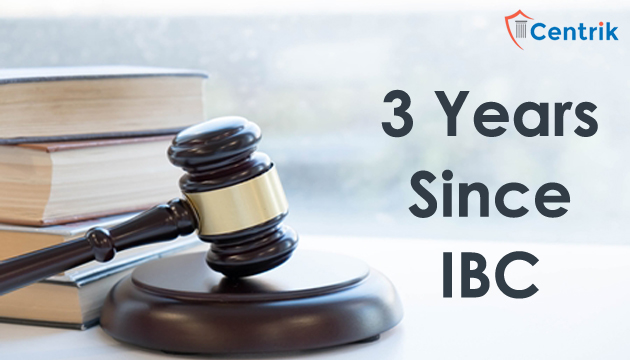
Status as on- 14/04/2020
The enactment of the Insolvency and Bankruptcy Code (IBC) was a watershed moment for the Indian economy, propelling the Indian economy into a new eco-system for corporate insolvency comprising of the Insolvency Professionals, Insolvency Professional Agencies, Insolvency and Bankruptcy Board of India and National Company Law Tribunal with the aim of promoting entrepreneurship and innovation.
The objective of the IBC was to consolidate a robust framework of insolvency laws that would additionally serve as a remedial measure to the prevailing malpractices in the Indian Banking and Corporate Sector. Thus over 3 years since its enactments, it is necessary to consider the hits and misses of this momentous legislation so as to truly exploit the potential of the insolvency regime.
Recovery of Stressed Assets
The IBC has successively addressed the logjams in the recovery of stressed assets and resolution timelines as per its intended objectives. Recovery through the IBC was double to amount recovered through other resolution mechanisms as per the Reserve Bank of India’s report on Trend and Progress of Banking in India 2017-18, the total bad loan recoveries under the IBC in FY 2018-19 was pegged at RS.70,000 crore compared to the recovery of Rs. 35,500 crore recovered through other resolution mechanisms such as the Debt Recovery Tribunal, Securitisation and Reconstruction of Financial Assets and Enforcement of Securities Interest Act, and Lok Adalat
Empowered Creditors
The stringent provisions of the IBC have instilled credit discipline and shifted the balance of power from the borrower to the creditor. This is reflected in a March 2019 report of the Insolvency and Bankruptcy Board of India which showed that almost Rs 2.02 lakh crore of debt pertaining to 4,452 cases were disposed of even before admission into the IBC process, as the borrowers made good the amounts in default to the creditors.
Resolution Timelines and overburdened Adjudicating Authority
Though in comparisons to other mechanisms under the law, the IBC has a much faster resolution mechanism (as per data available with the Reserve Bank of India (RBI) and IBBI, the average recovery rate for 90-odd cases resolved in IBC till March 2019 was 43 per cent higher than all the previous mechanisms such as Debt Recovery Tribunal, Securitisation and Reconstruction of Financial Assets and Enforcement of Securities Interest and Lok Adalat.), however, there is a need of improvement required to ensure that resolutions maintain the timeline as per the provisions under the IBC.
As per an EY report on IBBI Data, the following trends are observed;
- High Claims by financial creditors take more time to resolve;
- The average recovery rate rises with time;
- The average time for resolution and liquidation is rising. In fact, the recovery rate was just 12 per cent in the quarter ending December 2019, the lowest in at least two years;
- Resolution is more likely in the power and hospitality sector companies;
- Manufacturing chemical and metal witnessed more resolution;
- Labour intensive (employment friendly) leather and textile sectors mostly get liquidated;
- Real estate and construction sector go for an appeal or review the most;
The foremost solution to this to resolve the large burden of cases before the NCLT by increasing the NCLT Benches of the Adjudicating Authority so as to reduce the burden on the adjudicating authority, increase the number of appointments of Judicial Members/ experts, setting up alternative mechanisms for smaller cases, clarity on priority cases and so forth.
Homebuyers
The Recognition of Homebuyers under the IBC as being on power with financial creditors was a definitive move to not only empower middle-class Indian homebuyers and reboot the real estate sector in India through principles of transparency and accountability embedded in the provisions of the IBC, it was also a way to extricate about Rs 10 lakh crore stuck in debt in industries such as steel, cement, infrastructure financing and housing.
However, this groundbreaking legislative amendment second only to the enactment of the RERA for protection of Homebuyers was only momentary as the Ordinance of December 2019 once more limited the rights of the Homebuyers to access the insolvency regime against defaulting real estate developers. This has been a great shortcoming in the present insolvency regime.
The insolvency law framework is still in its burgeoning stages though there is much space for improvement, the proactive stance of the IBBI, Courts and the Legislature in seeking and acting on the feedback of stakeholders and in addressing the prevalent lacuna as they come up serves as a testament to its continual future success.
Disclaimer- The above article is based on the interpretation of related judicial pronouncement and related laws. The readers are expected to take expert opinion before relying on this article. For more information and clarification, please connect to us at support@centrik.in




 join For Updates
join For Updates